![]()
![]()
![]()
Use LEFT and RIGHT arrow keys to navigate between flashcards;
Use UP and DOWN arrow keys to flip the card;
H to show hint;
A reads text to speech;
29 Cards in this Set
- Front
- Back

Label/Homosporous or Heterosporous?
|

Homosporous
|
|

Label/Homosporous or Heterosporous?
|

Heterosporous
|
|
|
Have you read Campbell Chapter 30 yet?
|
All about the Evolution of seeds
|
|
|
Product of fertilized ovules?
|
seeds
|
|
|
integument-covered megasporangium?
|
ovule
|
|
|
seed coat, derived from the megasporophyll?
|
integument
|
|
|
Fertizilation animation?
|
http://www.blackredking.org/lifecycle/index.html
|
|
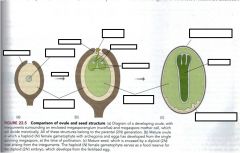
Label
|

=]
|
|
|
Do seed plants have spores?
|
yes
|
|
|
Advantages of seeds?
|
1. Seeds can remain dormant in soil for many years until favorable germination conditions occur.
2. Seed coats can be modified in ways to ad air dispersal. (Wings/fleshy coatings, etc.) 3. Seeds are diploid - have greater genetic variability 4. Liquid water is not required for fertilization |
|
|
Does pollen require liquid water for dispersal? How are sperm delivered to egg?
|
No. Sperm are delivered inside pollen grain to location of egg.
|
|
|
Steps in the Evolution of Seeds:
|
1. Development of heterospory
-----Increases chances of outcrossing -----Haploid gametophytes remain protected inside spore walls 2. Retention of megaspores within megasporangium (inhibit spore dispersal) 3. Reduction in the number of megaspores produced by each megasporangium ----Only one megaspore mother cell survives --> produces 4 cells by meiosis -----Only one mother cell product survives --> one megaspore develops into female gametophyte (megagametophyte) 4. Endospory: megaspore not dispersed but retained inside megasporangium 5. Development of integument (seed coat) with micropyle (opening for pollination) 6. Controlled dehydration --> dormancy |
|
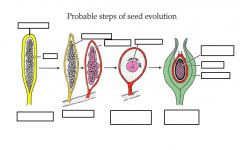
|

|
|
|
Gymnosperm phyla?
|
-Coniferophyta (conifers)
-Cycadophyta (cycads or sago palms) -Gingkophyta (Gingko biloba) -Gnetophyta (Gnetophytes) – currently thought to be most closely related to flowering plants |
|
|
What is an angiosperm?
|
Angio (vessel, container) + sperm (seed)
Seeds in a vessel Phylum Anthophyta Have flowers Seeds borne in fruits |
|

|
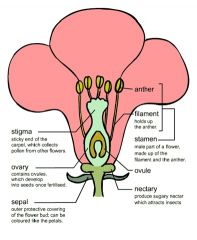
|
|
|
When did angiosperms first arise?
Major radiation? |
circa 150 million years ago
Major radiation: 65 mya at KT boundary |
|
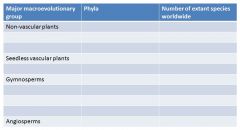
|

|
|
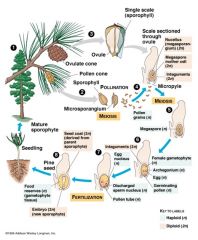
Review gymnosperm life cycle
|
Seed plants have new way of moving sperm to eggs: Pollen dispersed by wind
Microsporangia produce copious quantities of pollen so that some may blow onto micropyle, allowing access to ovule Production of copious quantities of pollen is costly to the plant since by far most pollen does not arrive at an ovule of the appropriate species. |
|
|
Evolution of flowers: WHY?
|
-Early insects (beetles) started stealing (eating) pollen before it was dispersed.
-Plants developed structures to attract insects -Pollination efficiency is enhanced (# pollinations/pollen grain) -Co-evolutionary reinforcement |
|
|
(Elaborate)
Early insects (beetles) started stealing (eating) pollen before it was dispersed. |
-Beetles began to specialize on feeding on pollen
-As beetles moved from plant to plant, some accidentally transferred pollen -Benefits of transferred pollen outweighed costs of stolen pollen |
|
|
(Elaborate)
Plants developed structures to attract insects |
-Petals, fragrances, nectar and other rewards
-Insects developed structures to be better at moving pollen, switched from feeding on pollen to feeding on nectar and other rewards |
|
|
(Elaborate)
Pollination efficiency is enhanced (# pollinations/pollen grain) |
-Plants produce less pollen, saving energy
-Plants expend less energy on attractants and rewards than they would otherwise spend on excessive pollen production while achieving better overall pollination success |
|
|
(Elaborate)
Co-evolutionary reinforcement |
-Plants develop structures to reward only particular pollinators because they don’t want “wrong” pollen clogging up their reproductive structures
-Insects develop structures to access the rewards -If either party “cheats” (steals reward or delivers pollen without a reward), then reinforcement is weakened |
|
|
How did angiosperm mutation/adaptive radiation occur?
|
Whole-genome duplication (WGD), or polyploidy, followed by gene loss and diploidization
(TWO ancestral WGD's) -Ancestral seed plant WGD -Ancestral angiosperm WGD |
|
|
Describe male side angiosperm life cycle
|
Anthers contain microsporangia (4) with microsporocytes
Microsporotcytes divide by meiosis to form 4 microspores Microspores divide by mitosis to form 2 cells within microspore wall, together these are the pollen grain or microgametophyte: Large tube cell Small generative cell Following pollination (landing on a receptive stigma), microgametophyte germinates Pollen tube starts growing from the tube cell Germinative cell divides by mitosis to form 2 sperm nuclei, which follow the tube nucleus down the pollen tube into the ovary |
|
|
Describe female side angiosperm life cycle
|
The ovary, or carpel, contains the ovules
Ovules contains nucellus = megasporangium, wrapped in two integuments with opening (micropyle) Megasporocyte developes from nucellus, divides by meiosis to form 4 haploid megaspores, 3 of which disintegrate Surviving megaspore develops into megagametophyte Megagametophyte nucleus divides to form 8 nuclei, 4 of which migrate to each end of the cell One nucleus from each group migrates to the center, which are then called polar nuclei The 3 nuclei near the micropyle are called the egg apparatus, the center one is the egg. Synergids and antipodals don’t do anything of importance |
|
|
Describe double fertilization in angiosperm life cycle
|
The pollen tube enters the ovule through the micropyle
One sperm nucleus fuses with the egg, forming the zygote (2n) The other sperm nucleus fuses with the two polar nuclei, forming the endosperm Endosperm is generally 3n but can be 5n or more in some species depending on variations on the development of the megagametophyte Zygote develops into the embryo Endosperm is nutritive tissue, which may remain in a single cell (e.g., in coconut) or may be absorbed into embryo (e.g., beans). Integuments develop into seed coats Ovary (and in some cases receptacle, too) develop into the fruit. |
|
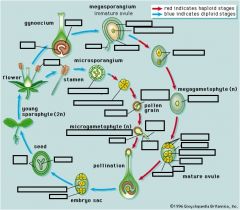
Angiosperm Life Cycle
|

Angiosperm Life Cycle
|

